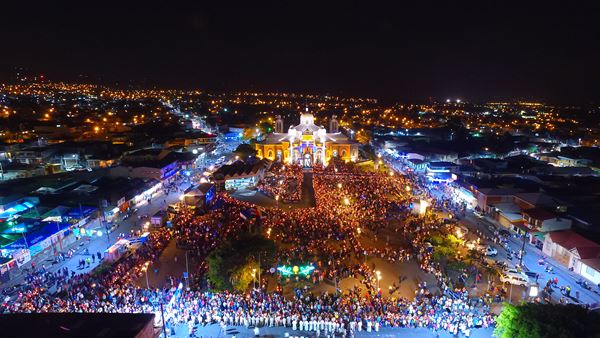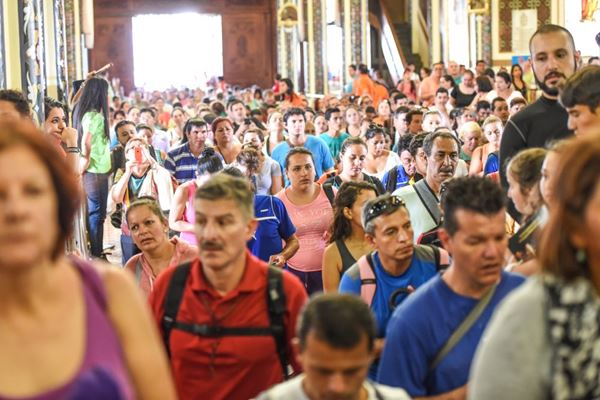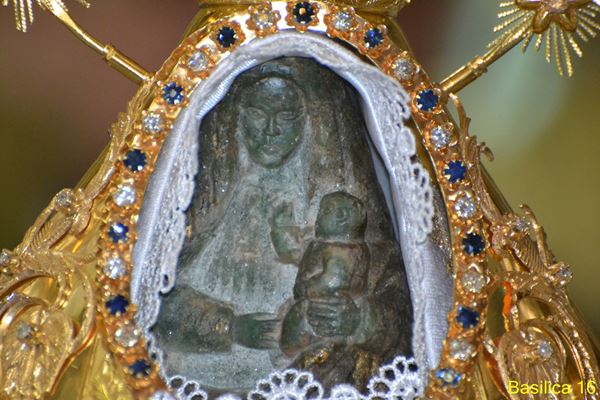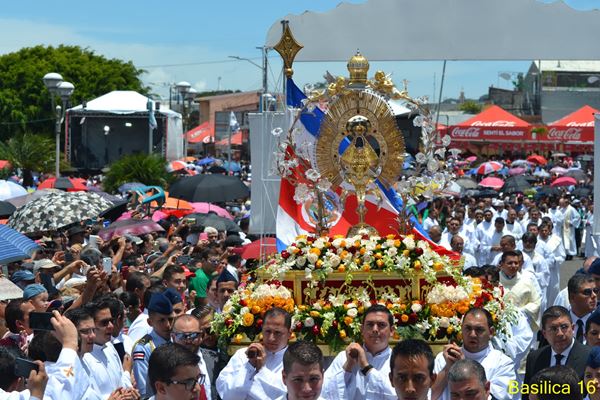
Cover Story – Pilgrimage or Fiesta? Romeria de la Virgen de Los Angeles
If you are in Costa Rica during the first days of August, especially the Cartago region, or happen to be on your way to the Irazu Volcano, you might find the roads blocked by thousands of people walking by. Surprise! You might be stuck in traffic for hours, thanks to the famous Romería de la Virgen de los Ángeles, or as many locals call it, La Negrita de los Ángeles. This traditional pilgrimage is very popular among all Costa Ricans, Roman Catholic or not.
 Ticos from all regions of the country take this sacred pilgrimage to the Basilica de los Ángeles in Cartago, home of Costa Rica’s patroness. But don’t be confused if it doesn’t really look like a pilgrimage. It’s more like a party than anything else. Instead of witnessing devotedly solemn Catholics, nuns and priests with crosses, praying and chanting songs along the way, you will find a mix of families, friends and party-goers, drinking and having fun. It looks like the kind of celebration you’d expect if the Seleccion had just won the World Cup, including tons of trash left behind, lots of lost dogs, countless bottles of beer – and of course, guaro! You know us Ticos, always finding a reason to have a good time.
Ticos from all regions of the country take this sacred pilgrimage to the Basilica de los Ángeles in Cartago, home of Costa Rica’s patroness. But don’t be confused if it doesn’t really look like a pilgrimage. It’s more like a party than anything else. Instead of witnessing devotedly solemn Catholics, nuns and priests with crosses, praying and chanting songs along the way, you will find a mix of families, friends and party-goers, drinking and having fun. It looks like the kind of celebration you’d expect if the Seleccion had just won the World Cup, including tons of trash left behind, lots of lost dogs, countless bottles of beer – and of course, guaro! You know us Ticos, always finding a reason to have a good time.
Of course it wasn’t always this way. We used to be a very devoted Catholic country and celebrations like this were taken very seriously. So let’s look back to the beginning to understand why Romería de la Virgen de los Ángeles is so popular.


The legend started in our country’s capital, when it was not San Jose – a little history lesson for all. The year was 1635, still during Spanish colonial rule. Cartago was the main city and capital, and times were very different back then. On August 2, Juana Pereira, a young girl from the Los Pardos tribe, went out to look for wood and water in the forest. Along the way, on top of a large rock, she found a stone doll of the Virgin Mary holding baby Jesus. Since no one was around to claim the doll, Juana wrapped it in cloths and took her prize home. The next day, taking the same route to repeat her errand, she found an identical doll on the same large stone. When she arrived home with this second doll, Juana realized the doll she had brought home yesterday was missing. This could only mean that the dolls she discovered in the same place, a day apart, were one and the same.
Scared and a little shaken, Juanita told her mother, who immediately took her and the doll to the local priest, Alonso de Sandoval. Somewhat skeptical, Father Alonso decided to lock the doll in a wooden box and guard it. To everyone’s surprise, when he unlocked the box the next day, the Virgin Mary doll was nowhere to be found. So the priest asked Juanita to show him the place in the forest where she had first found the doll, only to find it resting on the same large rock when she led him there.
Father Alonso then believed it was the stone Virgin’s will not to be taken anywhere else or locked away. He decided, along with other officials, to build a church on top of this place and make it her official home and resting place. The legend of this sacred place spread from town to town, and people from all around would walk into the forest to find the hidden chapel. This is how the pilgrimage began.
Since then, the Virgin’s name has changed several times. Originally, she was Patroness of the Pardos (all free black and brown people were called Pardos). Later on, she was named Patroness of Saint Mary of the Angels, because she appeared on August 2, Virgen de los Angeles Day. After that, she became known as Queen of Cartago and finally, in 1824, was named The Virgin of the Angels, official patroness of Costa Rica. Even Pope John Paul II, in 1983, declared her the official Patroness of Costa Rica and protector of the Americas.
The pilgrimage experience has also changed over the years. I can’t imagine how difficult it must have been at one time to walk through the deep forest on dirt paths and muddy trails to get to Cartago. I wonder how many days it might have taken a normal person to do this, or as time went on, how many people actually still did it.
Today’s Cartago pilgrimage is a spectacular event and Latin America’s most famous. More than 2.5 million visitors each year come from all corners of Costa Rica to give thanks to the Virgin, make petitions or request miracles.
Nowadays, the 22-kilometer trek from San Jose to Cartago follows asphalt roads and sidewalks all the way to the Basilica. It all starts on August 1. You might set out alone or with a small group of friends, but the further you go, the more people will start joining in the walk. You’ll see more locals than you can imagine, all carrying backpacks or bags with all the gear needed for the trip, including sun and rain protection. Some are using a walking stick to make the journey a bit easier.
 The closer you get to Curridabat the larger the crowd gets, all the way until you reach Tres Rios. There, transit officials will have closed the roads to vehicle traffic so you can enjoy a safer path. By now, you, along with hundreds of thousands of fellow travellers, will be starting the ascent of the Ochomogo Hills. Your comfort and safety is in good hands, with Red Cross stations providing water, first aid and places to rest. Police and transit officials provide additional support, as well as dozens of private organizations who assist with cleaning, recycling and even guarding the animals. It’s a beautiful and energizing walk with many markets and malls to stop at along the upward climb. Once at the top of the Ochomogo Hills, you’re rewarded with stunning views of the valley below. And when you finally get to Cartago City, you’ll be amazed by the throngs of people camping out on every available park and plaza space, enjoying barbecues and music in celebration with friends and family.
The closer you get to Curridabat the larger the crowd gets, all the way until you reach Tres Rios. There, transit officials will have closed the roads to vehicle traffic so you can enjoy a safer path. By now, you, along with hundreds of thousands of fellow travellers, will be starting the ascent of the Ochomogo Hills. Your comfort and safety is in good hands, with Red Cross stations providing water, first aid and places to rest. Police and transit officials provide additional support, as well as dozens of private organizations who assist with cleaning, recycling and even guarding the animals. It’s a beautiful and energizing walk with many markets and malls to stop at along the upward climb. Once at the top of the Ochomogo Hills, you’re rewarded with stunning views of the valley below. And when you finally get to Cartago City, you’ll be amazed by the throngs of people camping out on every available park and plaza space, enjoying barbecues and music in celebration with friends and family.
So if you find yourself stuck in traffic on or about August 2, trying to reach the Irazu Volcano, might as well put on your running shoes, get out of the car and walk with us to our sacred cathedral. Meet some nice locals, who will help and guide you along the way, and perhaps spend the night with some fun people. Next morning, enjoy mass on the main plaza in the prestigious company of the President of Costa Rica. You never know, you might have a petition yourself, or a promise or a claim for a miracle that was born in Costa Rica.


